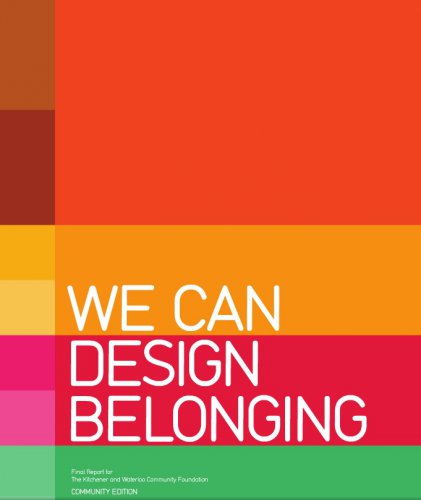This report is the culmination of ‘Belonging Is, a project for The Kitchener and Waterloo Community Foundation’ (The KWCF). The project emerged as a result of Waterloo Region’s Vital Signs®, an annual checkup through which The Kitchener and Waterloo Community Foundation measures the vitality of our Region, identifies significant trends and examines the priority areas critical to Waterloo Region’s quality of life. One of the categories in the report is Belonging and Leadership. For this category The KWCF assesses community engagement, with measures such as donation rates, volunteer rates and voter turnout, and belonging, with measures such as sense of belonging to the community and general satisfaction with life. In 2010, they found that 66% of the population expressed a sense of belonging that was ‘somewhat strong’ or ‘very strong.’ In 2012, this decreased to 62%. As well, they noted that their charitable donations are coming from a more and more narrow bracket of people: older adults with an annual income over $80 000. The KWCF community’s volunteer rate has fallen below the national and provincial averages and is now less than 42%. They also noted that youth and immigrants were underrepresented among volunteers and donors and notably absent from community leadership positions.
Download We Can Design Belonging
Project Goals
- To understand the state of belonging in Kitchener, Waterloo and Woolwich—what does belonging mean to people in the community? Do they feel like they belong here? Why or why not?
- To develop and prototype an approach for improving on the current state of belonging in Kitchener, Waterloo and Woolwich—how can we create an environment that encourages people to feel a strong sense of belonging to their community? How can The KWCF take action?
In their research, The KWCF saw that belonging benefits individuals and communities. People generally agree on what it feels like to belong: happy, safe, content, relaxed, supported, valued and accepted. Based on what we heard from participants, belonging is associated with good outcomes, such as relationship building, self-growth, helping others, collaborating, being cared for and having fun.
Table of Contents
EXECUTIVE SUMMARY
BACKGROUND
Why is belonging important?
The Project
The Difference between Belonging, Social Inclusion and Social Capital
OPPORTUNITY SPACE
Global Challenges and Change
Local Challenges
Challenges are Opportunities
METHODS
Soft Systems Methodology
Qualitative Research
Stakeholder Labs
Street Teams
Community Camp
1 on 1 Interviews
Analysis
KEY DISCOVERIES
Moments of Belonging
Obstacles to Belonging
Desired Outcomes of Belonging
Building Blocks of Belonging
Support for the Belonging Building Blocks
Mapping Community
Neighbourhoods
Demographic Differences
Belonging and Stage of Life
How People Describe Our Community
Community Connectedness: A Matter of Perception (Perception, Identity and Belonging)
COMMUNITY CAMP RESULTS
RECOMMENDED READING
APPENDIX: Community Camp Results
ENDNOTES





